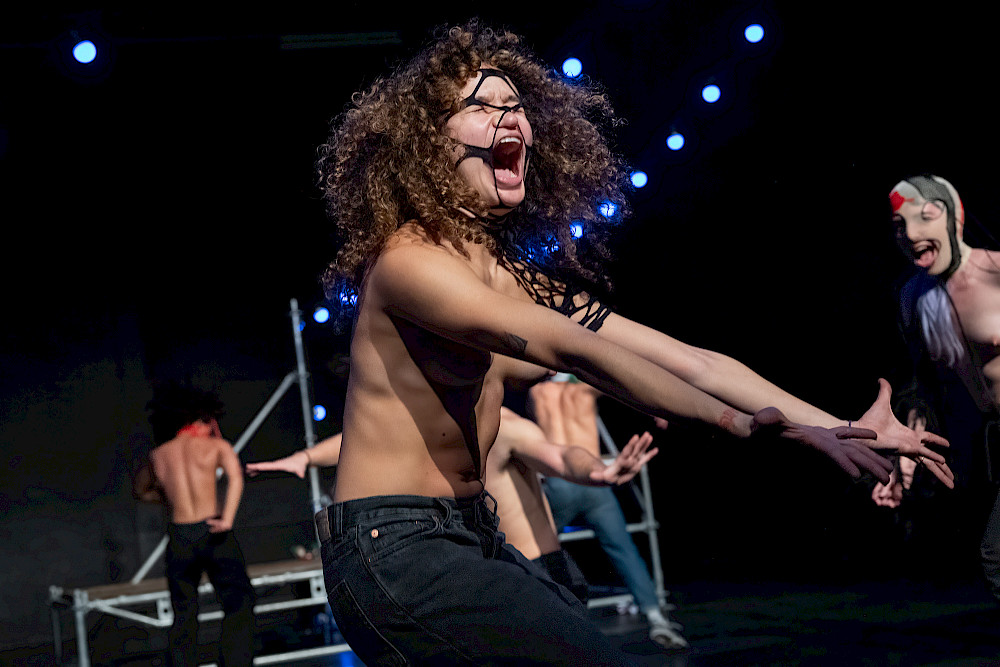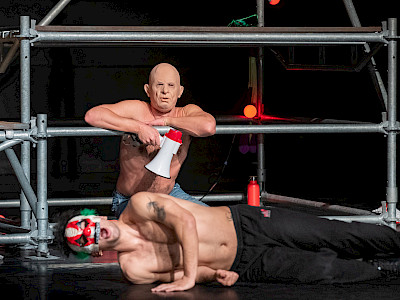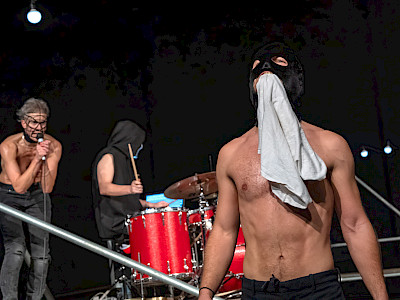16 — 18.05.2025
Nighttime wants to be celebrated collectively as a space for pleasure and delight, yet is also dangerous and bewildering. What do the night hours bring that temporarily suspends daily duties and rules? Choreographer Mette Ingvartsen, after The Dancing Public, continues her research into historical dancing manias and is a guest of the festival for the first time with this new performance.
Nine performers indulge in a delirious night of dance and music, inspired by the anonymous freedom of masked balls, strange carnivals, and derailed parties. Their bodies are propelled by contagious outbreaks of unstoppable dance and immersed in an ocean of uncontrollable sensations. Sometimes they fight the strong current, other times they surrender to the wild waves. Accompanied by live music from Will Guthrie, the dancers effortlessly navigate between hedonism and exorcism, joy and sadness, their bodies thriving in an intoxicating mood of togetherness. How can a state of de-control and excess drive the crowd to act?
Ingvartsen approaches bodily excesses as a reaction to exhaustion, stress, and emotional strain connected to a contemporary desire for transgression and transcendence. The result is an intense ode to the freedom the night brings.
"When Mette Ingvartsen takes something on, she wants to understand everything about it." – Mia Vaerman, 2023, the low countries
"Mette Ingvartsen’s energy is contagious, her dance from time to time hectic or more measured, mostly dismantling sexiness and gifting her body pure freedom." - Butterwort (about The Dancing Public), 2022, Butterwort
Relentless dance in times of crisis
Can you trace the genesis of Delirious Night? What were the driving forces behind this new research?
In Delirious Night we explore nighttime as a space where rules are suspended and where emotional states—often suppressed in daily life—can find expression. The choreography is based on the idea that affects and emotions are not only our own, but also something that shapes us collectively. Something contagious that has not only a personal but also a societal and political effect.
The piece is inspired by narratives and physical states derived from historical dancing epidemics—moments in time where bodies erupted into dancing in public space in ways that were inexplicable, excessive, and often uncontrollable. These events, observed in the streets of Europe during the Middle Ages, have been linked to moments of extreme distress—floods, famine, the plague, and political upheaval are only some of the causes you’ll find in historical interpretation. While their explanations remain multiple and uncertain, what interests me is how these episodes of unstoppable dance show how bodies absorbed and emotionally reacted to crisis. A topic I find uncannily relevant to our times today.
We are living in an increasingly unsettling world, facing environmental disasters, social injustice and political turmoil. And to me, it feels as if our bodies are more and more prone to be affected and unable to resist the pressures of those conditions. In that context, I am interested in how dancing could serve as a remedy—a speculative antidote to the challenges of our time—or as a way for us to dance ourselves out of emotional misery.
For this piece, you assembled a new team of dancers. How did you share your research with them?
Initially, I wanted to share nine historical dancing manias with them and structure the piece around nine different scenes. One of the references we used was the Kolbeck Dance of 1021, a myth where people were said to have danced themselves to death after being cursed outside a church. This narrative also represents resistance against the dominant institutional power of the time—the Church— making it an interesting case to study today, when forms of state governance and economic power are more diffuse and less tangible.
Another reference was Les bals des folles at La Salpêtrière in Paris in the 1880s. While Dr. Charcot did not invent these balls, they were popularized under his directorship. These gatherings allowed hysteric patients—often women institutionalized for being too expressive, too erotic, or nonconforming—to have a ball while the Parisian bourgeoisie was invited to socialize with them. The reason why I became interested in Charcot’s activities was that he explicitly connected the hysterical fits of his patients to the dancing manias of the Middle Ages in one of his publications. And I found the performative aspect of his approach both alarming and fascinating.
For Delirious Night, we also looked at the dances of the convulsionaries of the Saint-Médard graveyard in Paris, where people believed dance could bring about miraculous healing. The Italian Tarantella came up, as another example of a dancing mania believed to cure the effects of a poisonous spider bite. Apparently, the person bitten would dance, while the rest of the community would support this healing process by playing music, thus both healing the individual and the community at the same time. This idea of dance as a social healing force has become a crucial part of how I am thinking about the piece.
You invited percussionist Will Guthrie, with whom you had already collaborated. How did the music influence the piece?
Together with Will, we based the sound research on four fundamental activities: drumming, dancing, clapping, and singing—activities we derived from descriptions of various dancing manias. Will’s music explores ecstatic states and rhythmical structures that create different energetic responses among the dancers. We worked on the “unstoppable” dance, where his live drumming is combined withelectronic music, bringing a relentless momentum. When the dancers on stage tire from this unstoppable dance, their voices take over, trying to create a vocal polyphony that could be comparable to the sonority of a protest—expressing resistance but maybe also a certain level of despair. We worked on this idea of polyphony, by developing up to five
different vocal tracks at the same time, to create a kind of chaotic yet structured sonic experience.
You are collaborating once again with lighting designer Minna Tiikkainen. How did you and Minna envision the setup for Delirious Night?
For the scenography, Minna and I were inspired by the way theatre was performed in the Middle Ages on wagons that could move from one village square to another. This idea of a traveling stage, a kind of pop-up theatre, informed the way we worked with city scaffold materials— structures that are easily assembled, disassembled and moved, much like the wagons of medieval theatre. These materials also evoke temporary spaces used for modern gatherings, such as techno parties in forests or open fields. Another central element of the stage is the maypole, traditionally a focal point for communal dancing. Instead of the usual strings extending from it to create complex dances, we have created light lines that radiate outward, reinforcing the idea of a space that brings people together—a kind of roof under which we gather to dance. Minna is still developing the lighting design, working with colours, atmospheres, and intensity to enhance this experience of a ritual or a collective gathering.
How did you approach the work with masks for the piece?
I’ve collaborated with Jenny Defays, who crafted many of the masks from scratch, but also customized and changed existing ones. To me, masks hold different meanings in today’s society. On the one hand, they relate to anonymity and strategies for avoiding surveillance, offering a way to move unseen in a world of constant facial recognition. On the other hand, they have a strong presence in urban culture, used by musicians and performers to shift attention away from their individual identity. Also, during protest people shield themselves for protection and anonymity. In Delirious Night I also use masks to shun hyper-individualism, which is tied to contemporary capitalism and the pressures of personal self-exposure on social media. By covering the
face, masks allow us as performers to let go of our personal identities and become part of something larger, enabling the collective to prevail over the individual. Most of my work is about how to think differently about collectivity, and this work specifically searches for a polyphonic type of collectivity, where there is room for multiple voices and dissonance.
Beyond that, wearing a mask also simply feels liberating—it permits experimentation inside the piece, and allows us to work with vertiginous, delirious and hopefully contagious states.
- Interview conducted by Wilson Le Personnic, 15th of March 2025.
Wilson Le Personnic is a freelance writer. He writes for newspapers and theatres and in 2014 founded the maculture.fr website, which he ran until 2024.
Presentation: Kunstenfestivaldesarts, Kaaitheater, Cultuurcentrum De Factorij
Concept and choreography: Mette Ingvartsen | Performers: Dolores Hulan, Júlia Rúbies Subirós, Fouad Nafili, Jayson Batut, Mariana Miranda, Olivier Muller, Zoé Lakhnati, Thomas Bîrzan, Elisha Mercelina | Live music and composition: Will Guthrie | Lighting design: Minna Tiikkainen | Dramaturgy: Bojana Cvejić | Costumes: Jennifer Defays | Text and lyrics: Mette Ingvartsen, GRLwood, Sari and Romy Lightman | Vocal training and external ear: Fabienne Séveillac | Technical direction: Hans Meijer | Sound engineering: Milan Van Doren | Lighting technician: Bennert Vancottem | Technicians on tour: Jan-Simon De Lille, Filip Vilhemsson | Production management: Oihana Azpillaga Camio | Administration: Joey Ng | Communication: Jeroen Goffings | Management: Ruth Collier
Production: Great Investment | Coproduction: Kunstenfestivaldesarts, Kaaitheater, Kunstencentrum VIERNULVIER, Charleroi danse, Le Lieu Unique, Cndc Angers, PACT Zollverein, Theater Rotterdam, La Comédie de Clermont-Ferrand, Théâtre National de Bretagne, Le Quartz, Festival Madrid en Danza, Perpodium, Festival d’Avignon
Residencies: Charleroi danse, Rosas, Le Lieu Unique, P.A.R.T.S.
With the support of the Ammodo Foundation and the Fondation d’entreprise Hermès
Great Investment is supported by the Government of Flanders, the Flemish Community Commission (VGC), the Tax Shelter of the Belgian Federal Government and the Danish Arts Council



